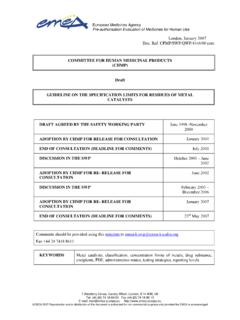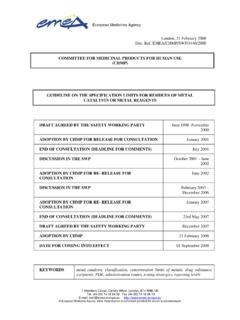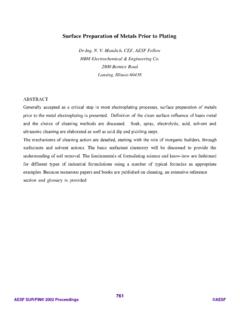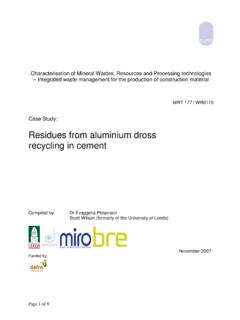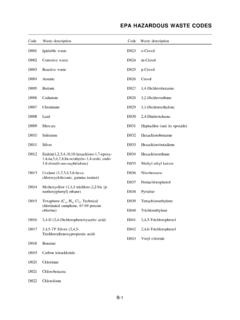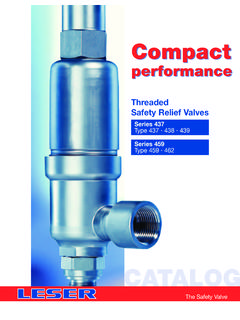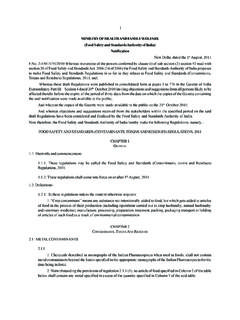Transcription of Gold Refining Community - Recycling
1 " Refining Precious Metals Wastes by CM. Hoke". Made available through the many generous donations of our members. Come Join Us At "Not for Re s a l e". CM. Hoke has written this book in non technical terms with easy to follow instructions. Notice Concerning Safety, First Aid, and Pollution Control Due to the enormous changes in these fields over the past fifty years, you should not rely on the information presented in this book but should consult current sources on these subjects gold Refining Community gold Refiners helping one another!
2 ACKNOWLEDGMENT. The list of friends and co-workers who have helped in the prepara- tion of this book is so long that space is lacking to give each the individual thanks that he deserves. I must, however, express my gratitude to T. R. McDearman, Margaret Stockford, Stanislaus Skowronski, Adolph Bregman, Edward Wichers, and the late Philip E. Browning, for especial courtesies. I wish to thank again the many authors and publishers who have granted permission for the use of their writings, and the several business organizations that have placed illustrations at my disposal.
3 In particular I wish to mention the frontispiece, copyrighted by the National Geographic Society, and reproduced from the National Geographic Magazine with special permission; and to thank Drs. Wichers and Gilchrist for their permission to use it here. PALISADE, NEW JERSEY. C. M. HOKE. January, 1940. PREFACE. This book is based on twenty-four years of experience in teaching jewelers and others how to refine their precious metal wastes. In many cases, especially at first, the instructions were given in person, at the jewelry factory or dental laboratory.
4 Mostly, how- ever, the instructions were given by mail, in the form of typed direction sheets, supplemented by replies to such questions as came to the student's mind. These instructions were prepared to meet the individual requirements of the user, and were adapted to the type of jewelry he made, the size of his shop, his own background of education or experience, and the kind of waste he happened to have on hand at the moment. This book is based on these oral and written instructions, and differs from them mainly in that it hopes to meet, in one volume, the needs of many workers handling many different problems.
5 It assumes complete inexperience on the part of the reader. For many centuries from the days of the Egyptians up to about 1900 the metals used in jewelry were gold and silver. Copper and zinc were added to cheapen and to strengthen them. The processes of melting and Refining were simple, well known, and adequately described in the literature. A young man wishing to learn the art or trade could do so either through the printed word, or by apprenticing himself to some older artisan. But at about the beginning of the 20th century, platinum entered the fields of jewelry-making and dentistry.
6 By the time we entered the first World War, it had burst like a nova into first magnitude in the jewelry firmament. Its sister metals, palladium and iridium especially, came with it. Immediately the problems of Refining , separating, and remelting the scrap metal became problems indeed. At first, say up to about 1915, comparatively few jewelry shops in the whole world were equipped to melt their platinum scrap, and the task of separating the platinum from the gold scrap was equally beyond their powers; a handful of professional refiners handled the entire output.
7 Reasons for this were several; preoccupation with viii PREFACE. war was only one. The habit of secrecy among many workers was a potent reason; the institution of apprenticeship was dying out;. the literature of platinum was scanty and so highly technical as to discourage the average reader. Platinum was so valuable that in many shops the proprietor did all the melting and Refining himself such as it was and excluded all workmen from the room where he worked, thus increasing the superstitions and misinformation that collected around the whole subject.
8 (A practical reason was the fact that the melting point of platinum is much higher than that of silver or gold ; so high, in fact, that an oxygen flame is required for melting it. That is, a gold -melting furnace, using gas or coke with compressed air, is not hot enough to melt platinum. The fuel must be combined with oxygen oxygen such as is now pro vided in steel cylinders in order to attain the necessary high tempera ture. The lack of compressed oxygen was a major factor in the non-use of platinum; its introduction at low prices was a major factor in its popularization.)
9 Nor were these the only complications that beset the precious- metal worker of the early Nineteen Hundreds. New gold alloys appeared white golds and green golds which made Refining more difficult. Electroplating became commoner, adding its cyanide solu- tions to the duties of the harassed refiners. Chromium and rhodium plating did their bit to complicate matters. Stamping laws that insisted upon definite percentages of metal and alloy added further to his legal, as well as his ethical responsibilities. Indeed it has been said, with truth, that there have been more changes in precious metal technology during the last thirty years, than during the previous thirty centuries.
10 Hence this book. TABLE OF CONTENTS. PAGE. PREFACE..vii CHAPTER. I. THE PURPOSE OF THE BOOK 1. What the book does. What it does not do. Is a knowledge of chemistry essential? How to use the book. II. MATERIALS TO BE DISCUSSED 4. Jewelers' wastes. Dental wastes. Photographers' wastes. Base metals present in precious metal wastes. Non-metallic admixtures. Old electroplating and stripping solutions. Economics of Refining the various kinds of wastes. III. THE SIMPLEST CASE PLATINUM FILINGS THAT CONTAIN. No gold II. Equipment and chemicals used.
